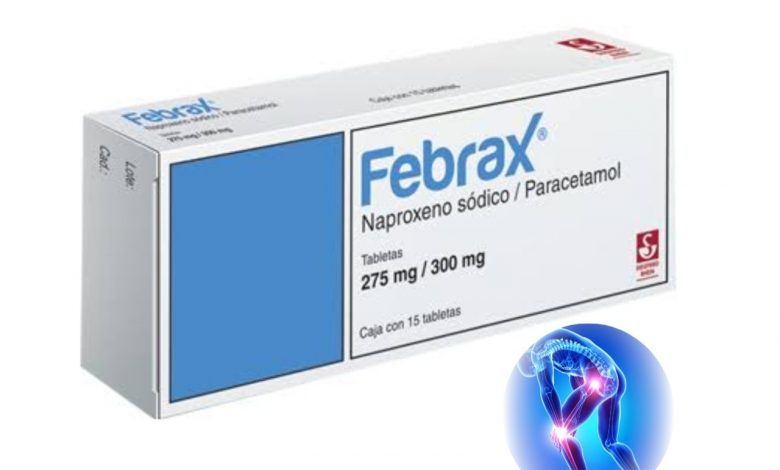Febrax Tablets: Ingredients, Uses, Benefits, Dosage, Side Effects, Interactions

What is Febrax tablet?
Febrax tablet is a combination pain and fever medication that contains naproxen sodium and paracetamol as active ingredients. Naproxen works by blocking the enzyme that produces prostaglandins. Prostaglandins play an essential role in inflammation. The body produces them at the site of injured tissue, and they cause redness, heat, swelling, and pain.
On the other hand, paracetamol work by blocking chemical messengers in the brain that tell us we have pain. Paracetamol also reduces fever by affecting the chemical messengers in an area of the brain that regulates body temperature.
In combination, these two medication work in synergy to treat fever, pain, and conditions such as moderate musculoskeletal pain, otalgia, headache, common cold symptoms, postoperative tonsil, and oropharyngeal surgery, dental procedures, and trauma.
Each tablet of Febrax contains naproxen sodium 275mg and paracetamol 300mg.

How should I take Febrax tablets?
The recommended dose of Febrax tablet for adults is 2 tablets as an initial dose, followed by 1 tablet every 6 to 8 hours until symptom control is obtained.
Follow the directions on the package or prescription label carefully, and ask your doctor or pharmacist to explain any part you do not understand. Take Febrax exactly as directed. Do not take more or less of it or take it more often than prescribed by your doctor or written on the package.
If you are taking Febrax tablet to relieve the symptoms of arthritis, your symptoms may begin to improve within 1 week. It may take 2 weeks or longer for you to feel the full benefit of the medication.
Stop taking Febrax tablet and call your doctor if your symptoms get worse, you develop new or unexpected symptoms, the part of your body that was painful becomes red or swollen, your pain lasts for more than 10 days, or your fever lasts for more than 3 days. Febrax tablets should not be administered for more than 10 days.
What are the side effects of Febrax tablet?
Common Febrax tablet side effects may include:
- Insomnia
- Indigestion
- Heartburn
- Stomach pain
- Nausea
- Vomiting
- Headache
- Dizziness
- Drowsiness
- Bruising
- Itching
- Rash
- Swelling or ringing in your ears
Febrax tablets can also cause serious side effects such as:
- Hemolytic anemia
- Cognitive dysfunction
- Moderate angioedema
- Alopecia
- Photosensitivity dermatitis
- Septic meningitis
- Erythema multiforme
- Ulcerative stomatitis
- Granulocytopenia
- Hematuria
- Stevens Johnson syndrome
- Fulminant hepatitis
- Hearing loss
- Jaundice
- Epidermal necrolysis
- Nephropathy
- Eeosinophilic pneumonitis
- Anaphylactic reactions
- Gastrointestinal bleeding and/or perforation
Get emergency medical help if you have signs of an allergic reaction to Febrax (runny or stuffy nose, wheezing or trouble breathing, hives, swelling in your face or throat) or a severe skin reaction (fever, sore throat, burning eyes, skin pain, red or purple skin rash with blistering and peeling).
Stop using Febrax tablets and seek medical treatment if you have a serious drug reaction that can affect many parts of your body. Symptoms may include skin rash, fever, swollen glands, muscle aches, severe weakness, unusual bruising, or yellowing of your skin or eyes.
Get emergency medical help if you have signs of a heart attack or stroke: chest pain spreading to your jaw or shoulder, sudden numbness or weakness on one side of the body, slurred speech, feeling short of breath.
Stop using Febrax tablet and call your doctor at once if you have:
• shortness of breath (even with mild exertion);
• swelling or rapid weight gain;
• the first sign of any skin rash, no matter how mild;
• signs of stomach bleeding – bloody or tarry stools, coughing up blood or vomit that looks like coffee grounds;
• liver problems – nausea, upper stomach pain, itching, tired feeling, flu-like symptoms, loss of appetite, dark urine, clay-colored stools, jaundice (yellowing of the skin or eyes);
• kidney problems – little or no urinating, painful or difficult urination, swelling in your feet or ankles, feeling tired or short of breath;
• low red blood cells (anemia) – pale skin, feeling light-headed or short of breath, rapid heart rate, trouble concentrating; or
• severe skin reaction – fever, sore throat, swelling in your face or tongue, burning in your eyes, skin pain followed by a red or purple skin rash that spreads (especially in the face or upper body) and causes blistering and peeling.
This is not a complete list of side effects and others may occur. Call your doctor for medical advice about side effects. You may report side effects to FDA at 1-800-FDA-1088.
Febrax may interact with other medications
Febrax oral tablets can interact with other medications, vitamins, or herbs you may be taking. An interaction is when a substance changes the way a drug works. This can be harmful or prevent the drug from working well.
To help avoid interactions, your doctor should manage all of your medications carefully. Be sure to tell your doctor about all medications, vitamins, or herbs you’re taking. To find out how this drug might interact with something else you’re taking, talk with your doctor or pharmacist.
Examples of drugs that can cause interactions with Febrax are listed below.
Antidepressant drugs
Combining selective serotonin reuptake inhibitors (SSRIs) with Febrax increases your risk of stomach and intestinal bleeding. Examples of these drugs include:
- citalopram
- fluoxetine
- fluvoxamine
- paroxetine
Blood pressure drugs
Febrax might make your blood pressure medications not work as well. If you’re older than 65 years, combining Febrax with certain blood pressure medications may damage your kidneys. Examples of these medications include:
- angiotensin-converting enzyme (ACE) inhibitors
- angiotensin receptor blockers
- beta-blockers, such as propranolol
- diuretics
Heartburn drugs and drugs that protect the stomach
Taking any of these medications with Febrax may make Febrax treat your pain more slowly:
- aluminum hydroxide
- magnesium oxide
- sucralfate
Nonsteroidal anti-inflammatory drugs (NSAIDs)
Combining Febrax with other NSAIDs increases your risk of stomach and intestinal bleeding. Examples of these medications include:
- aspirin
- ibuprofen
- etodolac
- diclofenac
- flurbiprofen
- ketoprofen
- ketorolac
Cholestyramine
If you take cholestyramine with Febrax, your body may absorb Febrax more slowly than usual. That means it may take longer to work.
Lithium
If you take Febrax with lithium, it may increase the lithium in your body to harmful levels.
Methotrexate
Taking methotrexate with Febrax can lead to harmful levels of methotrexate in your body.
Warfarin
Taking warfarin with Febrax increases your risk of stomach and intestinal bleeding.





